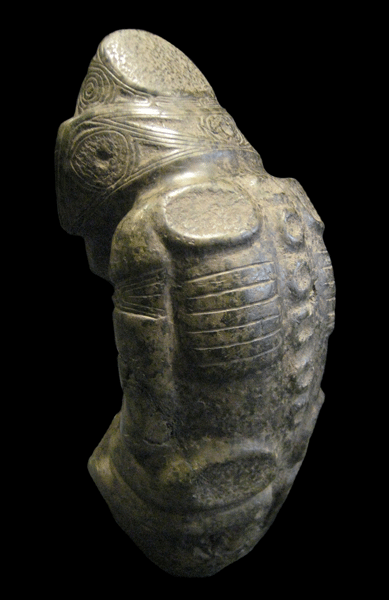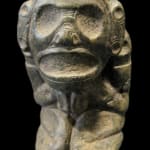Taino Stone Zemi Sculpture, 1200 CE - 1500 CE
Stone
12.5
LO.1321 (LSO)
This outstanding stone sculpture is a Zemi – the physical incarnation of a Taino god, spirit or ancestor. These were used by families and centralized magico-religious institutions on a village...
This outstanding stone sculpture is a Zemi – the physical incarnation of a Taino god, spirit or ancestor. These were used by families and centralized magico-religious institutions on a village scale, in order to “…help women with child…many which speak, and others that make grow the things that they eat, and others that bring rain, and others that make the wind blow” (Arrom 1974: 26). Historical accounts by Columbus, among others, also confirm a fertility role for at least some of the pieces, and they may also have helped relate the Taino’s mainland heritage as a story-telling device. Identifying specific pieces with specific gods or spirits is not always possible; the pantheon of gods is fairly well established (based around Yucahu – the god of cassava, the Taino staple crop – and his mother Antabey, who is responsible for fertility and water) but their physical appearances are generally undefined. Zemis have been found in various parts of the Caribbean, especially Hispaniola and Jamaica.
The piece is carved in a heavy, dark stone, and depicts a squat, powerful individual, kneeling with legs tucked beneath him and with hands under the chin in a pose suggestive of begging. His general proportions are skeletal – his face is reminiscent of a skull, with hollow eyes and nose, and all flesh seemingly absent. His body continues this theme, with ribs, scapulae and vertebral spines clearly marked on his back. Despite this apparent starvation, however, he is highly adorned, with detailed concentric carvings in bands on a decorated hat and armbands, and what appear to be tattoos on both shins and the bridge of the nose. The pedestal upon which he is kneeling is also decorated, with a single triangle and circle motif.
The Taino artistic repertoire is dominated by “three pointer”, or trigonolitos sculptures, which are themselves a subdivision of the Zemi sculptures. Effigy vessels, inhalers, vomit sticks (for purging during sacred rituals), mortars/pestles and amulets are also known, and all are decorated with elements visible in Zemi sculptures. The identity of the current piece is unclear. A wood figure with similar expressions has been recovered in Cuba, and is believed to represent some sort of fertility idol. Skeletal faces are also seen on more utilitarian artifacts such as inhalers, so their significance is open to question. It is however the Taino obsession with death which explains the probable purpose of the current piece. There is a comparatively small sample of artifacts that reflect issues of mortality and death, with skeletal features, emaciated bodies and forbidding expressions; these are partly anthropomorphic, and partly zoomorphic with particular emphasis on bats and owls, which were – and indeed are – viewed as harbingers of death. The art used to express this fear or acceptance of mortality takes the form of amulets that were worn, or optionally masks and figures for chiefs and people of high standing. The size and complexity of carving on the current piece makes it both unusual and desirable; it is a socially important work that has attained an aesthetic and artistic relevance in its own right.
The piece is carved in a heavy, dark stone, and depicts a squat, powerful individual, kneeling with legs tucked beneath him and with hands under the chin in a pose suggestive of begging. His general proportions are skeletal – his face is reminiscent of a skull, with hollow eyes and nose, and all flesh seemingly absent. His body continues this theme, with ribs, scapulae and vertebral spines clearly marked on his back. Despite this apparent starvation, however, he is highly adorned, with detailed concentric carvings in bands on a decorated hat and armbands, and what appear to be tattoos on both shins and the bridge of the nose. The pedestal upon which he is kneeling is also decorated, with a single triangle and circle motif.
The Taino artistic repertoire is dominated by “three pointer”, or trigonolitos sculptures, which are themselves a subdivision of the Zemi sculptures. Effigy vessels, inhalers, vomit sticks (for purging during sacred rituals), mortars/pestles and amulets are also known, and all are decorated with elements visible in Zemi sculptures. The identity of the current piece is unclear. A wood figure with similar expressions has been recovered in Cuba, and is believed to represent some sort of fertility idol. Skeletal faces are also seen on more utilitarian artifacts such as inhalers, so their significance is open to question. It is however the Taino obsession with death which explains the probable purpose of the current piece. There is a comparatively small sample of artifacts that reflect issues of mortality and death, with skeletal features, emaciated bodies and forbidding expressions; these are partly anthropomorphic, and partly zoomorphic with particular emphasis on bats and owls, which were – and indeed are – viewed as harbingers of death. The art used to express this fear or acceptance of mortality takes the form of amulets that were worn, or optionally masks and figures for chiefs and people of high standing. The size and complexity of carving on the current piece makes it both unusual and desirable; it is a socially important work that has attained an aesthetic and artistic relevance in its own right.



